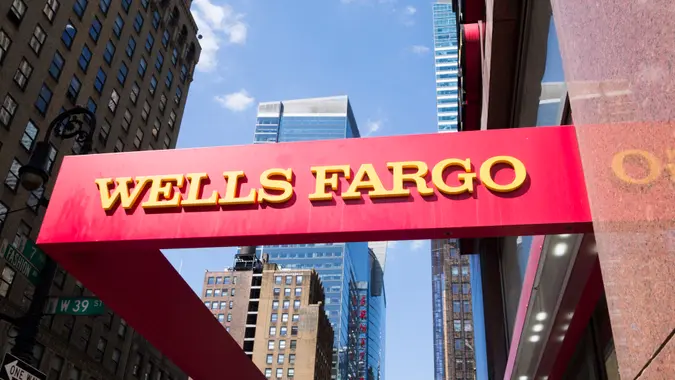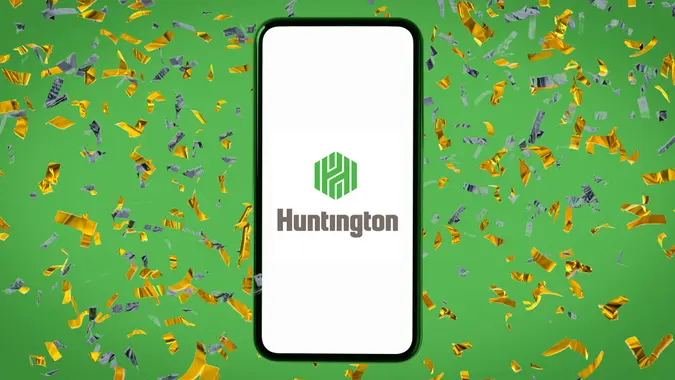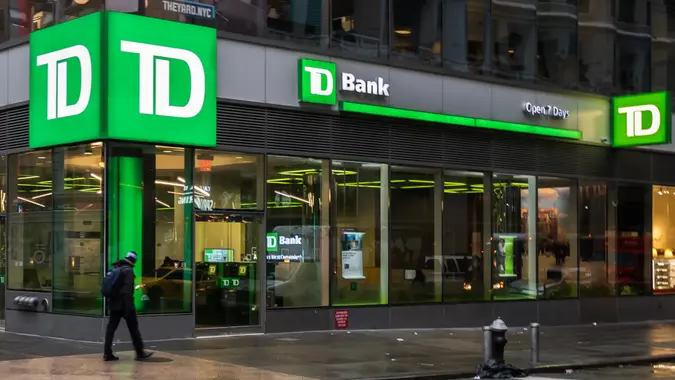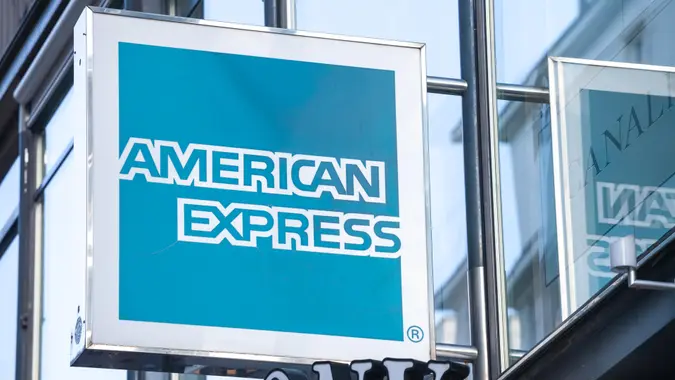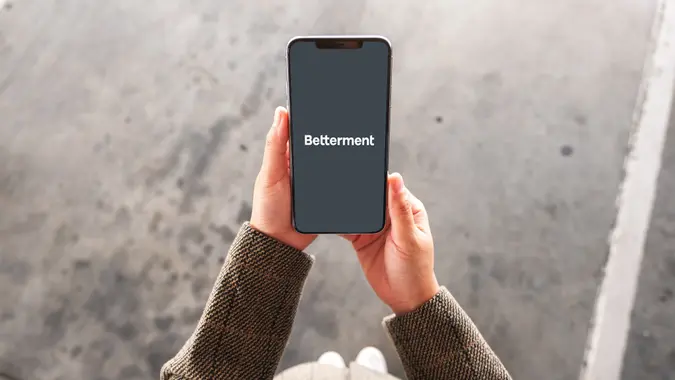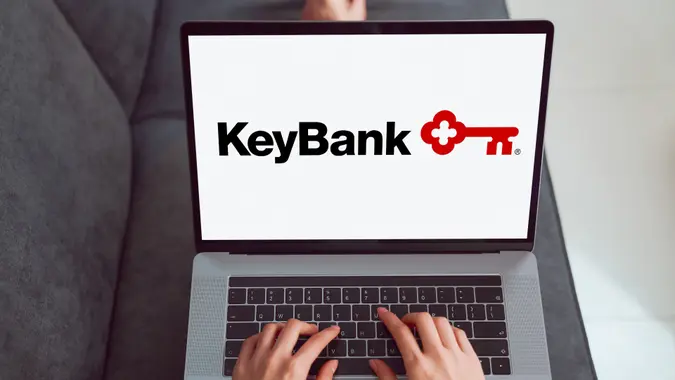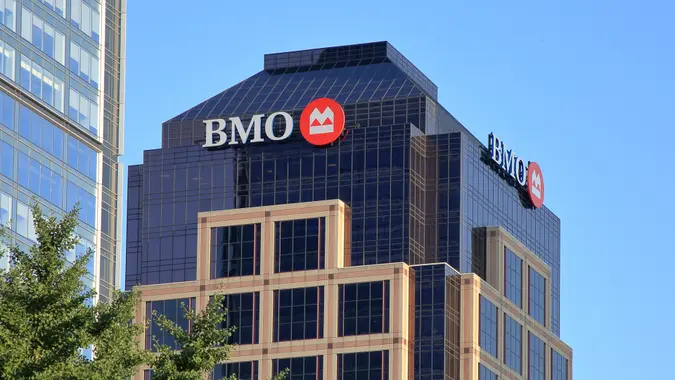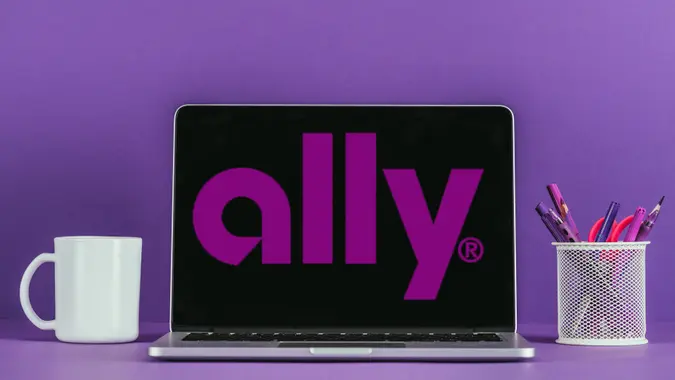Chase vs. Wells Fargo: Which Bank Is Better for Your Money

Commitment to Our Readers
GOBankingRates' editorial team is committed to bringing you unbiased reviews and information. We use data-driven methodologies to evaluate financial products and services - our reviews and ratings are not influenced by advertisers. You can read more about our editorial guidelines and our products and services review methodology.

20 Years
Helping You Live Richer

Reviewed
by Experts

Trusted by
Millions of Readers
Chase and Wells Fargo are two banking powerhouses. They both have branches nationwide and a variety of products for people and businesses. So which of the two giants is better? It all depends on what you’re looking for. This Chase versus Wells Fargo comparison will help you decide which bank is best.
Chase vs. Wells Fargo: Account Types
Here are the different account types the two banks have to offer personal banking customers.
| Account Type | Chase | Wells Fargo |
|---|---|---|
| Checking | – Chase Total Checking – Chase Secure Banking – Chase Premier Plus Checking – Chase Sapphire Banking – Chase Private Client Checking |
– Everyday Checking – Clear Access Banking – Prime Checking – Premier Checking |
| Savings | – Chase Savings – Chase Premier Savings |
– Way2Save Savings – Platinum Savings Account |
| CDs | 17 term options between 1 month and 120 months | 3 term options from 3 months to 1 year |
| Loans | -Mortgages -Home equity lines of credit -Car loans |
-Mortgages -Car loans |
| Other | -IRAs -Rollovers -Education accounts -Investing -Wealth management |
-IRAs -Rollovers -Education accounts -Investing -Wealth management |
Chase vs. Wells Fargo: Checking
Both banks offers several checking accounts to choose from. The monthly maintenance fees are comparable and there are easy ways to waive them. Chase’s Overdraft Assist* on the Chase Total Checking Account makes it a stand out among the two banks.
Chase
Chase offers five checking accounts: Chase Total Checking, Chase Secure Banking, Chase Premier Plus Checking, Chase Sapphire Banking and Chase Private Client Checking
- $4.95, $12, $5 — waived under certain conditions
- Chase Total Checking offers Chase Overdraft Assist, which waives fees if you’re less than $50 overdrawn
- No fees on money orders or cashier’s checks
- Comes with Zelle
- Pay bills with no fees using Chase Online Bill Pay
Wells Fargo
Wells Fargo offers four checking accounts: Everyday Checking, Clear Access Banking, Prime Checking and Premier Checking.
- $5, $10, $25 monthly maintenance fee — waived under certain conditions
- $25 to open
- Portfolio account pays interest
- Mobile deposits
- Budgeting tools
- Debit card controls
- Can link with Zelle
Chase vs. Wells Fargo: Savings
Both banks only have two savings accounts and the interest rates are on the lower end. Wells Fargo’s Platinum Savings account has the highest interest rate. However, you’ll have to qualify for the relationship account and it’s still much lower than the national average of 0.41.
Chase
Chase has the Chase Savings and Chase Premier Savings account.
- –
- No minimum opening deposits
- $5-$25 monthly service fee – waived under certain conditions
- Autosave feature
- Online, mobile banking available
Wells Fargo
Wells Fargo has the Way2Save Savings and Platinum Savings Account.
Link your savings account to your Wells Fargo checking account to avoid high overdraft fees.
- –
- $25 minimum opening deposit
- $5, $12 monthly maintenance fee — waived under certain conditions
- Automatic savings options available
- Use for overdraft protection for linked checking account
- Online, mobile banking available
Chase vs. Wells Fargo: CDs
Chase
Chase offers CDs with relationship and non-relationship rates.
- Minimum deposits: $1,000
- Terms: 1 to 120 months
- Automatic renewals
Wells Fargo
Wells Fargo offers a standard fixed-rate CD.
- Minimum deposits: $2,500
- Terms: 3 months to 1 year — check with a branch about availability of other terms
- Automatic renewals
Chase vs. Wells Fargo: Rates
If you plan on depositing your savings with either bank, earning the highest interest possible should be one of the top reasons to choose one bank over the other.
| Account | Chase Rate | Wells Fargo Rate |
|---|---|---|
| Checking | ||
| Savings | ||
| CDs | ||
| Loans | – Mortgage rates: Depends on down payment and home price – Auto rates: Depends on financing amount, Car condition and brand |
-Auto Loans: Rates aren’t published -Personal Loans: As low as -Mortgage rates: (30 year Fixed) and (15 year Fixed) |
Chase vs. Wells Fargo: Fees
As you can see, both banks offer customers plenty of options to manage their money. But how much will it cost you? Here is how Chase’s fees compare to Wells Fargo’s.
| Type of Fee | Chase Cost | Wells Fargo Cost |
|---|---|---|
| Monthly Maintenance | $4.95, $5, $6, $12, $25, $35 | $5, $10, $25 |
| Overdraft/Non-Sufficient Funds | $34 per item, up to 3 per business day* | $35 per item, up to 3 per business day |
| ATM | -Non-Chase domestic: $2.50 for some accounts -Non-Chase international: $5 for some accounts |
-Non-Wells Fargo domestic: $2.50 -Non-Wells Fargo international: $5 |
| Replacement Debit Card | $0 fee for standard shipping; $5 for rush requests for some accounts | $0 fee |
| Cashier’s Check | $8 each for some accounts | $10 each for some accounts |
| Wire Transfer | -Domestic and international incoming: $15 or $0 when sent via Chase banker, Chase.com or Chase Mobile -Domestic outgoing with assistance from Chase banker: $35 -Domestic online outgoing: $25 -International outgoing with assistance from Chase banker: $50 -International USD online outgoing: $40 -International FX online outgoing: $5 or $0 for $5,000 USD or more -Wire transfers are not available with all accounts; some accounts have free transfers |
-Domestic outgoing: $30 -International outgoing: Starts at $35 -Incoming domestic: $15 -Incoming international: $16 |
Is Chase Better Than Wells Fargo?
No two people are alike — and neither are the services of competing banks. Chase might be better than Wells Fargo when you’re on a tight budget and tend to incur overdraft fees.
Overdraft Fees
Wells Fargo’s overdraft fees are slightly higher than Chase’s, and the fee applies if your account is overdrawn over $5, whereas Chase has a more generous policy.
You have a chance to avoid an overdraft fee if your account is overdrawn no more than $50 or if the account had sufficient funds at the moment the bank authorized the purchase that overdrew the account.
Savings Options
If you want to maximize your savings, however, Wells Fargo beats Chase on how much you can earn in interest on CDs, but you’ll need a relationship account to qualify.
If you’re interested in a wider variety of CD terms or premium checking accounts, Chase is the better option.
Tips To Pick the Right Bank
When comparing banks, there are several factors you should consider so you can narrow down your options. The following tips can help you choose the best bank for you.
Choose a Bank With Low Fees
Look for accounts with no fees or those that waive monthly maintenance charges for certain activities. This includes setting up direct deposits, using your debit card or maintaining a minimum balance.
Also take into consideration any other fees for actions, such as for closing your account, inactivity and even replacing a lost or stolen card.
Watch Out for Overdraft Fees
Some banks charge as much as $35 for each overdraft, making it one of the most expensive fees a bank charges. Even worse, a bank may allow multiple overdraft fees per day, which could seriously put a dent in your balance. If you occasionally overdraw your account, look closely at how the bank handles overdrafts and the order they use to process credits and debits to your account.
Research Sign-Up Bonuses
Many banks provide cash sign-up bonuses when you open a new account. You could earn hundreds of dollars simply by giving a new bank a try.
Ask Your Friends and Family
Word-of-mouth is one of the best ways to know how a bank may work for you. Ask your friends, family and work colleagues about which financial institution they bank with. Find out what they like about the bank and what they think could improve.
Their experience can provide you with good insight into how the bank could benefit you.
Consider Accessibility
Depending on your banking habits and how comfortable you are with online or mobile banking, you may want to choose a bank with physical branches where you can get in-person help with your banking.
Mobile Apps Offer Convenience
A user-friendly app with mobile check deposit and free ways to send money to friends and family can improve your banking experience by reducing your need for checks and the number of visits you need to make to the ATM.
If you’re comfortable with online banking, do some research on each bank you’re considering and how its mobile banking app works.
What Are Your Financial Goals?
If you’re actively saving for retirement or growing your savings, choose a bank with robust retirement and investment features.
Depending on where you are in your financial journey, you may want a bank that provides more than a checking account. In most cases, banks will give you special discounts or preferential rates on their loan, insurance and savings products if you already bank with the institution.
Allison Hache, Cynthia Measom and Daria Uhlig contributed to the reporting for this article.
FAQ
- Which bank has better checking account options, Chase or Wells Fargo?
- The accounts are pretty comparable, but the Chase Total Checking Account's Overdraft Assist feature stands out the most between both banks.
- Are there any fees associated with Chase or Wells Fargo accounts?
- Yes, many of the account have monthly maintenance fees. However, they can be waived by doing things like maintaining a certain account balance and setting up direct deposit.
- Which bank offers more loan options, Chase or Wells Fargo?
- Both banks offer mortgages and auto loans. However, only Wells Fargo offers personal loans.
Rates are subject to change; unless otherwise noted, rates are updated periodically. All other information on accounts is accurate as of Apr. 7, 2023.
*With Chase Overdraft AssistSM, Chase won’t charge an insufficient funds fee if you’re overdrawn by $50 or less at the end of the business day, or if you’re overdrawn by more than $50 and you bring your account balance to overdrawn by $50 or less at the end of the next business day (you have until 11 p.m. ET, or 8 p.m. PT, to make a deposit or transfer). Chase Overdraft Assist does not require enrollment and comes with eligible Chase checking accounts.
Chase Total Checking has a monthly fee of $12 or $0 with one of the following, each monthly statement period: Electronic deposits made into this account totaling $500 or more, such as payments from payroll providers or government benefit providers, by using (i) the ACH network, (ii) the Real Time Payment or FedNowSM network, (iii) third party services that facilitate payments to your debit card using the Visa® or Mastercard® network, OR a balance at the beginning of each day of $1,500 or more in this account, OR an average beginning day balance of $5,000 or more in any combination of this account and linked qualifying Chase checking, savings, and other balances.
Editorial Note: This content is not provided by Chase. Any opinions, analyses, reviews, ratings or recommendations expressed in this article are those of the author alone and have not been reviewed, approved or otherwise endorsed by Chase.
Our in-house research team and on-site financial experts work together to create content that’s accurate, impartial, and up to date. We fact-check every single statistic, quote and fact using trusted primary resources to make sure the information we provide is correct. You can learn more about GOBankingRates’ processes and standards in our editorial policy.
 Written by
Written by  Edited by
Edited by 



